-
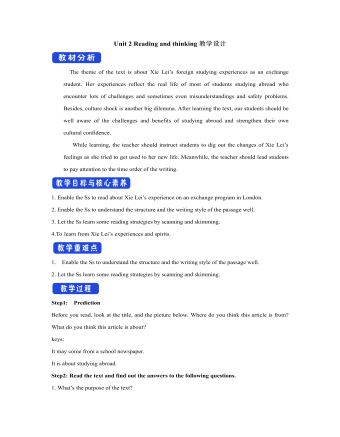
新人教版高中英语选修2Unit 2 Reading and thinking教学设计
Her tutor told her to acknowledge __________ other people had said if she cited their ideas, and advised her _______(read) lots of information in order to form __________wise opinion of her own.Now halfway __________ her exchange year, Xie Lei felt much more at home in the UK. She said __________ (engage) in British culture had helped and that she had been__________ (involve) in social activities. She also said while learning about business, she was acting as a cultural messenger __________(build) a bridge between the two countries. keys:Xie Lei, a 19yearold Chinese student, said goodbye to her family and friends in China and boarded (board) a plane for London six months ago in order to get a business qualification. She was ambitious(ambition) to set up a business after graduation. It was the first time that she had left (leave) home.At first, Xie Lei had to adapt to life in a different country. She chose to live with a host family, who can help with her adaptation (adapt) to the new culture. When she missed home, she felt comforted (comfort) to have a second family. Also Xie Lei had to satisfy academic requirements. Her tutor told her to acknowledge what other people had said if she cited their ideas, and advised her to read lots of information in order to form a wise opinion of her own.Now halfway through her exchange year, Xie Lei felt much more at home in the UK. She said engaging (engage) in British culture had helped and that she had been involved (involve) in social activities. She also said while learning about business, she was acting as a cultural messenger building a bridge between the two countries.
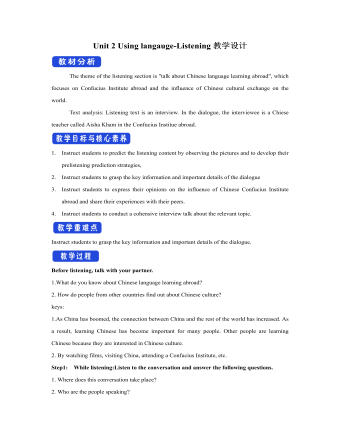
新人教版高中英语选修2Unit 2 Using langauge-Listening教学设计
? B: Absolutely! Getting involved with Chinese cultural activities there definitely helped a lot. I got to practice my Chinese on a daily basis, and I could learn how native Chinese speakers spoke.? A: What do you feel is your biggest achievement?? B: Learning Chinese characters! I have learnt about 1,500 so far. When I first started, I didn't think it was even going to be possible to learn so many, but now I find that I can read signs, menus, and even some easy newspaper articles.? A: What are you most keen on?? B: I've really become keen on learning more about the Chinese culture, in particular Chinese calligraphy. As I have learnt Chinese characters, I have developed a great appreciation for their meaning. I want to explore Chinese characters by learning how to write them in a more beautiful way. ? A: Finally, what do you want to say to anyone interested in learning Chinese?? I have really become keen on learning more about the Chinese culture, in particular Chinese Calligraphy. As I have learnt Chinese character, I have developed a great appreciation for their meaning. I want to explore Chinese characters by learning how to write them in a more beautiful way.? A: Finally, what do you want to say to anyone interested in learning Chinese?? B: I'd say, give it a shot! While some aspects may be difficult, it is quite rewarding and you will be happy that you tried.? A: Thanks for your time. ? B:You're welcome.
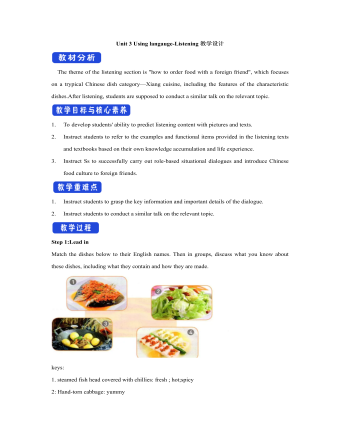
新人教版高中英语选修2Unit 3 Using langauge-Listening教学设计
1. How is Hunan cuisine somewhat different from Sichuan cuisine?The heat in Sichuan cuisine comes from chilies and Sichuan peppercorns. Human cuisine is often hotter and the heat comes from just chilies.2.What are the reasons why Hunan people like spicy food?Because they are a bold people. But many Chinese people think that hot food helps them overcome the effects of rainy or wet weather.3.Why do so many people love steamed fish head covered with chilies?People love it because the meat is quite tender and there are very few small bones.4.Why does Tingting recommend bridge tofu instead of dry pot duck with golden buns?Because bridge tofu has a lighter taste.5 .Why is red braised pork the most famous dish?Because Chairman Mao was from Hunan, and this was his favorite food.Step 5: Instruct students to make a short presentation to the class about your choice. Use the example and useful phrases below to help them.? In groups of three, discuss what types of restaurant you would like to take a foreign visitor to, and why. Then take turns role-playing taking your foreign guest to the restaurant you have chosen. One of you should act as the foreign guest, one as the Chinese host, and one as the waiter or waitress. You may start like this:? EXAMPLE? A: I really love spicy food, so what dish would you recommend?? B: I suggest Mapo tofu.? A: Really ? what's that?
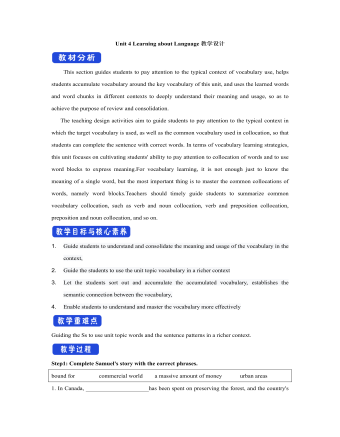
新人教版高中英语选修2Unit 4 Learning about Language教学设计
This section guides students to pay attention to the typical context of vocabulary use, helps students accumulate vocabulary around the key vocabulary of this unit, and uses the learned words and word chunks in different contexts to deeply understand their meaning and usage, so as to achieve the purpose of review and consolidation.The teaching design activities aim to guide students to pay attention to the typical context in which the target vocabulary is used, as well as the common vocabulary used in collocation, so that students can complete the sentence with correct words. In terms of vocabulary learning strategies, this unit focuses on cultivating students' ability to pay attention to collocation of words and to use word blocks to express meaning.For vocabulary learning, it is not enough just to know the meaning of a single word, but the most important thing is to master the common collocations of words, namely word blocks.Teachers should timely guide students to summarize common vocabulary collocation, such as verb and noun collocation, verb and preposition collocation, preposition and noun collocation, and so on.1. Guide students to understand and consolidate the meaning and usage of the vocabulary in the context, 2. Guide the students to use the unit topic vocabulary in a richer context3. Let the students sort out and accumulate the accumulated vocabulary, establishes the semantic connection between the vocabulary,4. Enable students to understand and master the vocabulary more effectivelyGuiding the Ss to use unit topic words and the sentence patterns in a richer context.
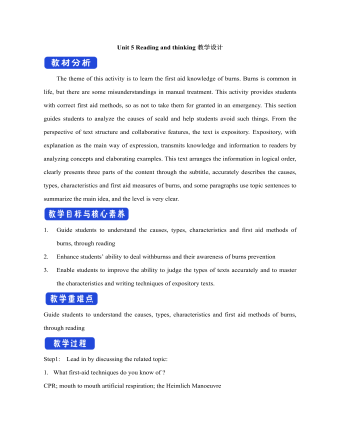
新人教版高中英语选修2Unit 5 Reading and thinking教学设计
The theme of this activity is to learn the first aid knowledge of burns. Burns is common in life, but there are some misunderstandings in manual treatment. This activity provides students with correct first aid methods, so as not to take them for granted in an emergency. This section guides students to analyze the causes of scald and help students avoid such things. From the perspective of text structure and collaborative features, the text is expository. Expository, with explanation as the main way of expression, transmits knowledge and information to readers by analyzing concepts and elaborating examples. This text arranges the information in logical order, clearly presents three parts of the content through the subtitle, accurately describes the causes, types, characteristics and first aid measures of burns, and some paragraphs use topic sentences to summarize the main idea, and the level is very clear.1. Guide students to understand the causes, types, characteristics and first aid methods of burns, through reading2. Enhance students’ ability to deal withburnss and their awareness of burns prevention3. Enable students to improve the ability to judge the types of texts accurately and to master the characteristics and writing techniques of expository texts.Guide students to understand the causes, types, characteristics and first aid methods of burns, through readingStep1: Lead in by discussing the related topic:1. What first-aid techniques do you know of ?CPR; mouth to mouth artificial respiration; the Heimlich Manoeuvre
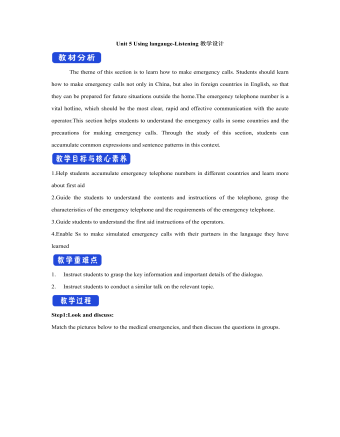
新人教版高中英语选修2Unit 5 Using langauge-Listening教学设计
The theme of this section is to learn how to make emergency calls. Students should learn how to make emergency calls not only in China, but also in foreign countries in English, so that they can be prepared for future situations outside the home.The emergency telephone number is a vital hotline, which should be the most clear, rapid and effective communication with the acute operator.This section helps students to understand the emergency calls in some countries and the precautions for making emergency calls. Through the study of this section, students can accumulate common expressions and sentence patterns in this context. 1.Help students accumulate emergency telephone numbers in different countries and learn more about first aid2.Guide the students to understand the contents and instructions of the telephone, grasp the characteristics of the emergency telephone and the requirements of the emergency telephone.3.Guide students to understand the first aid instructions of the operators.4.Enable Ss to make simulated emergency calls with their partners in the language they have learned1. Instruct students to grasp the key information and important details of the dialogue.2. Instruct students to conduct a similar talk on the relevant topic.Step1:Look and discuss:Match the pictures below to the medical emergencies, and then discuss the questions in groups.

新人教版高中英语必修3Unit 2 Morals and Virtues教学设计二
Activity 41. Students complete the task of activity 4, then teachers and students check the answers. 2. The teacher organized the students to work together and asked them to use the tables and mind maps sorted out before to retold the important choices in Lin Qiaozhi's life and their resultsStep 5 Language points1. The teacher asks the students to read the text carefully, find out the core words and long and difficult sentences in the text and draw lines, understand the use of vocabulary, and analyze the structure of long and difficult sentences. 2. The teacher explains and summarizes the usage of core vocabulary and asks the students to take notes. 3. The teacher analyzes and explains the long and difficult sentences that the students don't understand, so that the students can understand them better. Step 6 Homework1. Read the text again, in-depth understanding of the text; 2. Master the use of core vocabulary and understand the long and difficult sentences. 3. Complete relevant exercises in the guide plan. 1、通过本节内容学习,学生是否理解和掌握阅读文本中的新词汇的意义与用法;2、通过本节内容学习,学生能否结合文本特点总结林巧稚的人生原则和人格品质特征;3、通过本节内容学习,学生能否针对人生抉择发表自己的看法;能否全面地、客观地、理性地看待问题,进而对道德和人性有更加深入的思考和理解。
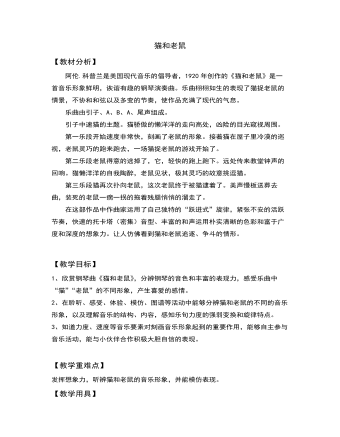
二年级音乐欣赏猫和老鼠教案教学设计
阿伦.科普兰是美国现代音乐的倡导者,1920年创作的《猫和老鼠》是一首音乐形象鲜明,诙谐有趣的钢琴演奏曲。乐曲栩栩如生的表现了猫捉老鼠的情景,不协和和弦以及多变的节奏,使作品充满了现代的气息。乐曲由引子、A、B、A、尾声组成。引子中速猫的主题。猫骄傲的懒洋洋的走向高处,凶险的目光窥视周围。第一乐段开始速度非常快,刻画了老鼠的形象。接着猫在屋子里冷漠的巡视,老鼠灵巧的跑来跑去,一场猫捉老鼠的游戏开始了。第二乐段老鼠得意的逃掉了,它,轻快的跑上跑下。远处传来教堂钟声的回响。猫懒洋洋的自我陶醉,老鼠见状,极其灵巧的故意挑逗猫。第三乐段猫再次扑向老鼠,这次老鼠终于被猫逮着了。美声慢板送葬去曲,装死的老鼠一瘸一拐的拖着残腿悄悄的溜走了。在这部作品中作曲家运用了自己独特的“跃进式”旋律,紧张不安的活跃节奏,快速的托卡塔(密集)音型、丰富的和声运用朴实清晰的色彩和富于广度和深度的想象力。让人仿佛看到猫和老鼠追逐、争斗的情形。
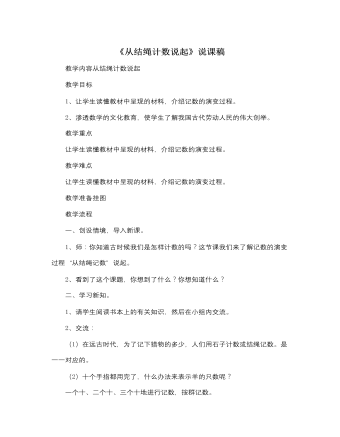
北师大版小学数学四年级上册《从结绳计数说起》说课稿
教学内容从结绳计数说起教学目标1、让学生读懂教材中呈现的材料,介绍记数的演变过程。2、渗透数学的文化教育,使学生了解我国古代劳动人民的伟大创举。教学重点让学生读懂教材中呈现的材料,介绍记数的演变过程。教学难点让学生读懂教材中呈现的材料,介绍记数的演变过程。教学准备挂图教学流程一、创设情境,导入新课。1、师:你知道古时候我们是怎样计数的吗?这节课我们来了解记数的演变过程“从结绳记数”说起。2、看到了这个课题,你想到了什么?你想知道什么?二、学习新知。1、请学生阅读书本上的有关知识,然后在小组内交流。2、交流:(1)在远古时代,为了记下猎物的多少,人们用石子计数或结绳记数。是一一对应的。
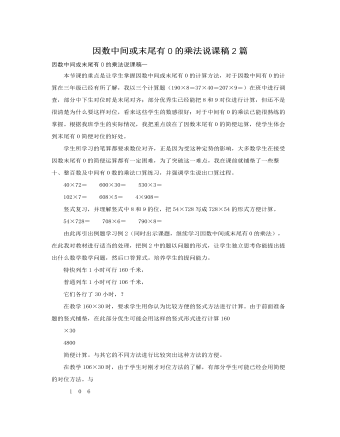
人教版新课标小学数学四年级上册因数中间或末尾有0的乘法说课稿2篇
然后我让自主尝试探索末尾有0有乘法,然后让学生自己上台来给大家展示各自的算法,并讨论比较那种算法更简便,从而总结出末尾有0的乘法列竖式的简便方法。为了解决这节课的重点和难点,我在这个环节里又有针对性的设计了两个练习,一个是0和非0的对位,还有一个是积末尾补0。在教学因数中间有0的乘法,因为学生有了前面的基础,所以我直接让学生在两个问题中选择一个解决。重点强调了因数中间0不能漏乘。在练习方面,我设计了看谁的眼睛亮,通过找错误,学生练习时,老师观察到有共性的的错误,通过视频展示台,让学生来寻找错误,再次突破本课的重点。一题是360×25因数末数一共有一个0,而积的末尾应该有三个0。让学生进行讨论,再一次让学生体会了积末尾0个数确定的方法。在巩固和拓展联系环节,设计了闯关游戏,先是基本的计算练习,接着是因数末尾0个数的判断和解决问题的联系,通过练习,巩固竖式的简便写法,提高学生的计算能力。
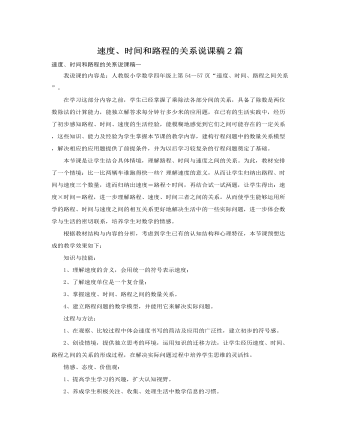
人教版新课标小学数学四年级上册速度、时间和路程的关系说课稿2篇
二、教材分析本节课是让学生结合具体情境,理解路程、时间与速度之间的关系。为此,教材安排了一个情境:比一比两辆车谁跑得快一些?从而让学生归纳出路程、时间与速度三个数量,进而归纳出速度=路程÷时间,再结合试一试两题,让学生得出:路程=速度×时间,时间=路程÷速度,进一步理解路程、速度、时间三者之间的关系。因此,理解路程、时间与速度之间的关系是本节课的重点,难点是速度的单位。学习了这节课,学生可以解决生活中的一些实际问题,并且可以合理地安排时间,提高效率。三、学情分析学生对于路程、时间与速度的关系一定有所了解,但他们虽然知道三者之间的数量关系式,却并不十分了解为什么有这样的关系。因此,在课上应遵循“问题情境---建立模式---解释应用”的基本叙述模式,为学生自主参与、探究和交流提供时间和空间。四、教学目标
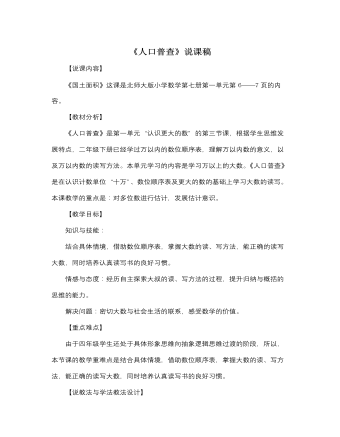
北师大版小学数学四年级上册《人口普查》说课稿
【说课内容】《国土面积》这课是北师大版小学数学第七册第一单元第6——7页的内容。【教材分析】《人口普查》是第一单元“认识更大的数”的第三节课,根据学生思维发展特点,二年级下册已经学过万以内的数位顺序表,理解万以内数的意义,以及万以内数的读写方法。本单元学习的内容是学习万以上的大数。《人口普查》是在认识计数单位“十万”、数位顺序表及更大的数的基础上学习大数的读写。本课教学的重点是:对多位数进行估计,发展估计意识。【教学目标】知识与技能:结合具体情境,借助数位顺序表,掌握大数的读、写方法,能正确的读写大数,同时培养认真读写书的良好习惯。情感与态度:经历自主探索大叔的读、写方法的过程,提升归纳与概括的思维的能力。
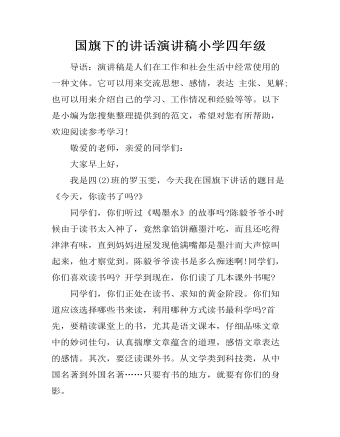
国旗下的讲话演讲稿小学四年级
导语:演讲稿是人们在工作和社会生活中经常使用的一种文体。它可以用来交流思想、感情,表达 主张、见解;也可以用来介绍自己的学习、工作情况和经验等等。以下是小编为您搜集整理提供到的范文,希望对您有所帮助,欢迎阅读参考学习!敬爱的老师,亲爱的同学们:大家早上好,我是四(2)班的罗玉雯,今天我在国旗下讲话的题目是《今天,你读书了吗?》同学们,你们听过《喝墨水》的故事吗?陈毅爷爷小时候由于读书太入神了,竟然拿馅饼蘸墨汁吃,而且还吃得津津有味,直到妈妈进屋发现他满嘴都是墨汁而大声惊叫起来,他才察觉到。陈毅爷爷读书是多么痴迷啊!同学们,你们喜欢读书吗? 开学到现在,你们读了几本课外书呢?同学们,你们正处在读书、求知的黄金阶段。你们知道应该选择哪些书来读,利用哪种方式读书最科学吗?首先,要精读课堂上的书,尤其是语文课本,仔细品味文章中的妙词佳句,认真揣摩文章蕴含的道理,感悟文章表达的感情。其次,要泛读课外书。从文学类到科技类,从中国名著到外国名著……只要有书的地方,就要有你们的身影。读书,需要时间。时间在哪里?它就在我们每一个人的双手里。你一松手,它就从指间溜走了因此,读书需要只争朝夕。一早到校,可以读书;午间休息,可以读书;睡觉之前,可以读书。
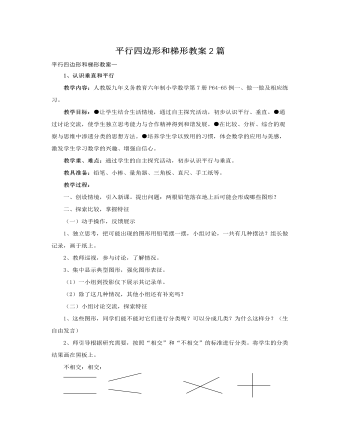
人教版新课标小学数学四年级上册平行四边形和梯形教案2篇
3、师:不相交的两条直线画长一些会怎样?量一量两条相交直线做组成的角分别是多少度?4、由小组同学在原记录单上动手合作操作,并进行讨论、汇报。5、师生共同总结:不相交的两条直线画长一些仍不相交,这两条直线叫平行线,也可以说它们相互平行;相交的两条直线形成的四个角,如果都是90度,就说这两条直线相互垂直,其中一条叫另外一条的垂线,这两条直线的焦点叫做垂足。6、生齐读P65平行和垂直概念,并画下来。7、今天我们就要一起来认识认识平行与垂直。(揭示课题)三、解释应用,巩固新知1、我们天天都在和垂线与平行线打交道:书本面相邻的两边是互相垂直的,相对的两边是互相平行的。2、P64主题图,找一找,图上有哪些平行和垂直的现象?3、做一做1找一找、想一想还有哪些物体的边是互相垂直的,哪些物体的边是互相平行的?
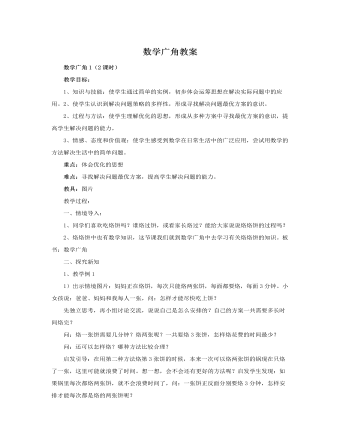
人教版新课标小学数学四年级上册数学广角教案
教学目标:知识与技能:1、使学生初步体会对策论方法在解决实际问题中的应用。2使学生认识到解决问题策略的多样性,形成寻找解决问题最优方案的意识。3、培养学生的应用意识和解决实际问题的能力。过程与方法:使学生理解优化的思想,形成从多种方案中寻找最优方案的意识,提高学生解决问题的能力。情感、态度和价值观:使学生感受到数学在日常生活中的广泛应用,尝试用数学的方法解决生活中的简单问题。重点:体会优化的思想难点:寻找解决问题最优方案,提高学生解决问题的能力。教具:图片教学过程:一、情境导入:1、你们听过“田忌赛马“的故事吗?田忌是怎样赢了齐王的?谁能给大家讲一讲这个故事?2、问:田忌的马都不如齐王的马,但他却赢了?这是为什么呢?3、这节课我们就来研究研究。板书课题:数学广角
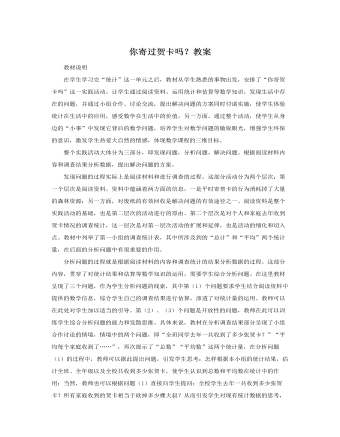
人教版新课标小学数学四年级上册你寄过贺卡吗?教案
整个实践活动大体分为三部分,即发现问题,分析问题,解决问题。根据阅读材料内容和调查结果分析数据,提出解决问题的方案。发现问题的过程实际上是阅读材料和进行调查的过程。这部分活动分为两个层次:第一个层次是阅读资料。资料中蕴涵着两方面的信息,一是平时寄贺卡的行为消耗掉了大量的森林资源;另一方面,对废纸的有效回收是解决问题的有效途径之一。阅读资料是整个实践活动的基础,也是第二层次的活动进行的原由。第二个层次是对个人和家庭去年收到贺卡情况的调查统计,这一层次是对第一层次活动的扩展和延伸,也是活动的细化和切入点。教材中列举了第一小组的调查统计表,其中所涉及到的“总计”和“平均”两个统计量,在后面的分析问题中有很重要的作用。分析问题的过程就是根据阅读材料的内容和调查统计的结果分析数据的过程。这部分内容,贯穿了对统计结果和估算等数学知识的运用,需要学生综合分析问题。

人教版新课标小学数学四年级上册三位数乘两位数教案2篇
教学目标:1、使学生能根据两位数乘两位数的笔算方法,推出并掌握三位数乘两位数的笔算方法。2、进一步培养学生的计算能力。教学过程:一、自主探索笔算方法。1、出示例1:李叔叔从某城市乘火车去北京用了12小时,火车1小时约行145千米。该城市到北京大约有多少千米?2、独立列式:145×12=3、请学生估一估145×12的大致范围。4、尝试算出145×12的结果,并对照估算的情况,算一算估算值与准确值的误差是否合乎实际。5、让学生说一说计算过程。应说以下几点:(1)先算什么;(2)再算什么,积的书写位置怎样;(3)最后算什么。6、师生共同归纳三位数乘两位数笔算一般方法的过程。7、引导学生用不同的方法检验自己运算的结果。二、巩固练习1、课本49页“做一做”学生独立用竖式计算,完成后,可能计算器自行检验。
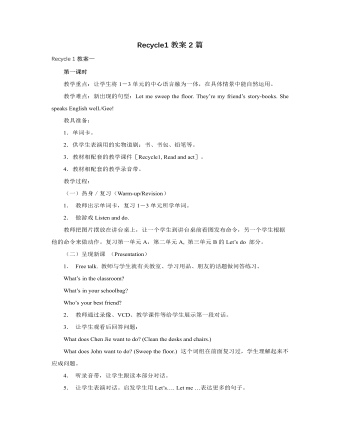
人教版新课标PEP小学英语四年级上册Recycle1教案2篇
Part two1. Teaching AimsMaster the 26 letters.Master the pronunciation of the letters.2. Teaching Aidsa tape-recorder, some cards, some papers and so on.3. Important pointsThe pronunciation of the letters4. Teaching steps1) Greetings and revisionLet some groups act out the dialogue in the last lesson.2) New contentsLet them say out the 26 letters and let some ones say them out.Then listen and learn the letters song.First, give them some minutes and let them read the letters. Let’s see whether there is anyone who can learn anything in them. Then give them some information and let them read again. At last, give them the answer and read again.Let them remember it.PracticeShow the cards where are written the math patterns and let some answer it. Then ask “Who can read it in English?” Let some one read it. Others follow him.Next, show the cards and ask others answer them. T asks and S answers. Then S asks and S answers. Practice in pairs.HomeworkMaster the letters.Teaching notesPart three1. Teaching AimsIntroduce self and others using the words and phrases.Let’s play.2. Teaching Aidsa tape-recorder, some cards3. Important pointsShe has…She likes…I have…4. Teaching stepsGreetings and revisionLet some one read the letters and divide them by the pronunciations.
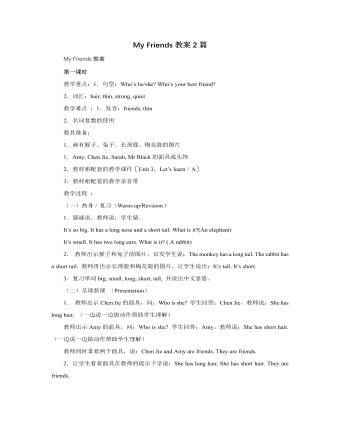
人教版新课标PEP小学英语四年级上册My Friends教案2篇
1.叫一名学生在班里走动,站在一名学生的后面。 2.教师举起一张本单元的单词图片。先正确地说出这个单词第一个字母的读音的学生坐下,另一名学生继续在班里走动,继续活动。 板书设计 :My friends 黑板上方:上课前打好的四线三格,在课堂上随讲随写的字母Ww, Xx, Yy, Zz 黑板下方: 教案点评: 本课时主要学习字母Ww, Xx, Yy, Zz及相关单词。因为本课时将结束字母的学习,因此在热身、复习环节,有必要先进行字母Aa-Vv的听写。然后出示字母卡、单词卡让学生认读字母和复习单词。呈现新课环节,教师可将字母教学放到单词中进行。在教学过程 中,教师结合图片或实物逐个进行字母和单词的教学,可辅以字母课件进行教学,便于学生更好的领会和掌握。教师要注意侧重字母的书写教学,使学生养成正确的书写习惯。两个小游戏“Bingo”和“Listen and show”帮助学生在趣味活动中巩固了所学的全部字母。扩展性活动的设计目的在于复习本单元的单词。
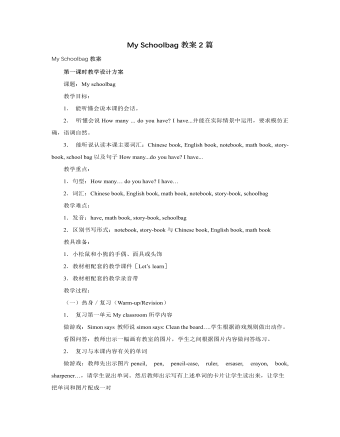
人教版新课标PEP小学英语四年级上册My Schoolbag教案2篇
教师问:Can you spell these words? 如有学生能够拼出单词,教师要给与表扬并说:那让我们来看一看他拼的对不对,然后出示单词卡。如没有学生拼出单词,教师说:我们学习单词不仅要会说还要会写,今天我们就来学习几个单词的拼写,看谁学得快。然后出示单词卡。 让学生看单词卡拼读单词。 教师让学生看单词回答:How many letters in this word?学生回答后,让他们背着拼出单词。 教师让学生在四线三格中默写字母b, o, k, r, l, e, p, n, c, I, a,教师教学生在四线三格中书写单词。告诉学生首先要把每个字母书写正确,然后按照单词的拼写把字母写在一起,注意单词的每个字母间要有一点距离。教师在教写ruler和pencil-case时, 注意小写u和s还没有学习书写,让学生照着板书写就可以了。 让学生照板书抄字头,然后每个单词写一行。 (三)趣味操练(Practice)





















